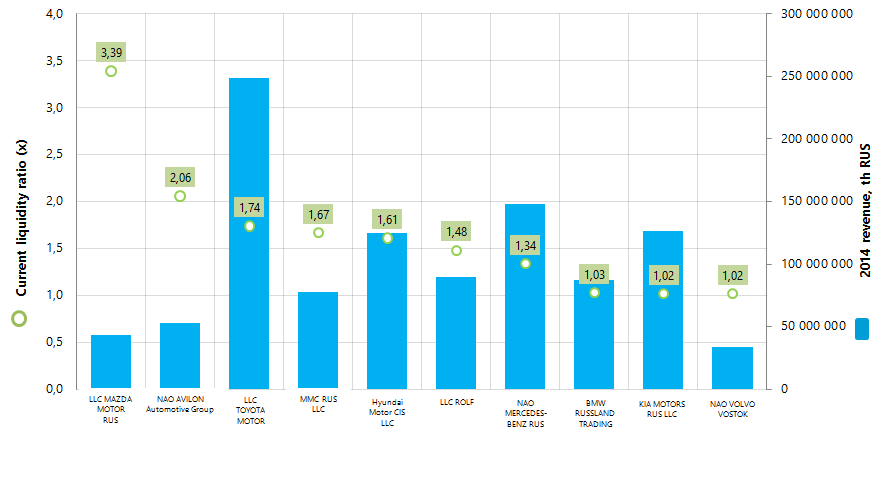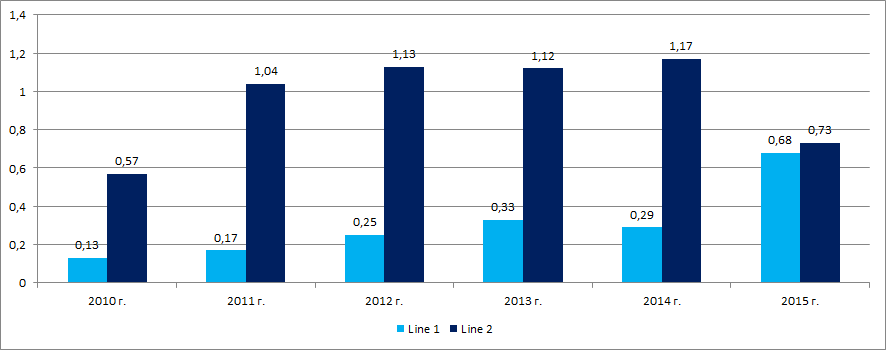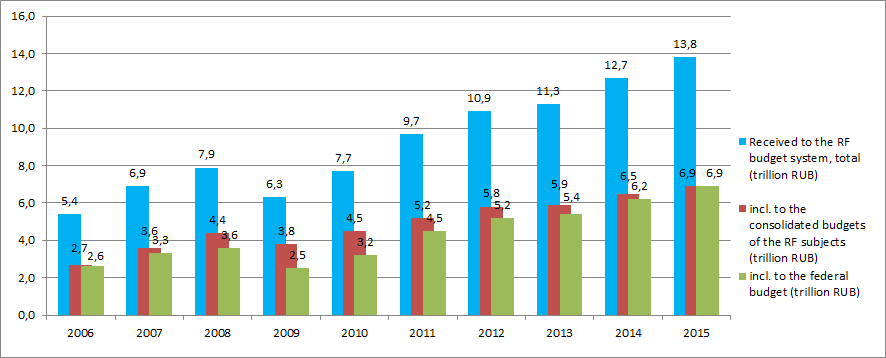Current liquidity ratio of the largest Russian auto dealers
Information Agency Credinform has prepared the ranking of Russian auto dealers. TOP-10 largest enterprises in terms of revenue were selected according to the data from the Statistical Register for the latest available period (for the year 2014). Then, the companies were ranged by Current liquidity ratio (Table 1).
Current liquidity ratio (х) (coverage ratio) is a ratio of total working capital to short-term liabilities. The ratio shows the sufficiency of company’s assets to meet short-term obligations.
The recommended value is from 1,0 to 2,0. The ratio value less than 1 indicates about the excess of short-term liabilities over current working capital.
For the most full and fair opinion about the company’s financial position, not only compliance with standard values should be taken into account, but also the whole set of financial indicators and ratios.
| Name, INN, Region | 2014 net profit, th RUB | 2014 revenue, th RUB | 2014/2013 revenue, % | Current liquidity ratio, (х) | Solvency index Globas-i |
|---|---|---|---|---|---|
| LLC MAZDA MOTOR RUS INN 7743580770, Moscow |
2 775 897 | 43 119 554 | 120 | 3,39 | 151 The highest |
| NAO AVILON Automotive Group INN 7705133757, Moscow |
1 305 918 | 52 596 319 | 114 | 2,06 | 163 The highest |
| LLC TOYOTA MOTOR INN 7710390358, Moscow region |
4 019 401 | 248 627 531 | 108 | 1,74 | 207 High |
| MMC RUS LLC INN 7715397999, Moscow |
1 510 594 | 77 580 644 | 108 | 1,67 | 208 High |
| Hyundai Motor CIS LLC INN 7703623202, Moscow |
1 227 890 | 124 843 324 | 112 | 1,61 | 238 High |
| LLC ROLF INN 5047059383, Moscow region |
2 732 356 | 89 443 332 | 132 | 1,48 | 190 The highest |
| NAO MERCEDES-BENZ RUS INN 7707016368, Moscow |
5 720 774 | 147 624 280 | 123 | 1,34 | 205 High |
| GESELLSCHAFT MIT BESCHRANKTER HAFTUNG "BMW RUSSLAND TRADING ООО" INN7712107050, Moscow |
-1 002 893 | 87 607 721 | 108 | 1,03 | 263 High |
| KIA MOTORS RUS LLC INN 7728674093, Moscow |
-8 202 055 | 126 362 972 | 104 | 1,02 | 282 High |
| NAO VOLVO VOSTOK INN 5032048798, Kaluga region |
-144 541 | 33 477 074 | 90 | 1,02 | 279 High |
The current liquidity ratio of TOP-10 companies varies from 3,39 to 1,02, that satisfies the lower bound of recommended values. In 2014, with industry average value of 1.28, the average ratio of 10 largest auto dealers amounted to 1,64.
All participants of TOP-10 have the highest and high solvency index Globas-i, that shows their stable financial condition.
First two places of the ranking take LLC MAZDA MOTOR RUS and NAO AVILON Automotive Group with Current liquidity ratios, exceeding the upper bound of recommended values, as current assets of the enterprises significantly exceed short-term liabilities. According to 2013 results the leaders of the ranking were LLC JAGUAR LAND ROVER and HONDA MOTOR RUS LLC with ratio values 3,28 and 2,87 accordingly. According to 2014 results these two companies were not included in TOP-10.
Picture 1. 2014 revenue and current liquidity ratio of the largest Russian auto dealers (TOP-10)

According to 2014 results, the annual revenue of TOP-10 enterprises amounted to 1 031 bln RUB, that is 12% higher than total revenue in 2013. However, net profit indicators of these companies demonstrate negative dynamics. Thus, 2014 total net profit of TOP-10 enterprises amounted to 9,9 bln RUB, it decreased by 53% in comparison with previous period. Only 4 out 10 participants (LLC MAZDA MOTOR RUS, MMC RUS LLC, LLC ROLF, NAO MERCEDES-BENZ RUS) increased net profit in 2014. Other companies showed decline or even net loss.
Taking into account the increased inflation and reduced consumer demand, the industry as a whole demonstrates negative dynamics. For example, below is the data from the Federal State Statistics Service about the stock of cars in trade enterprises in comparison with the data about wholesale sales of passenger cars, including light cars, minibuses, special passenger cars etc. (Picture 2).

The analysis shows the threefold increase in car stocks among trade industry in 2015 with almost 40% decline in sales in monetary terms.
Auto dealers are characterized by high concentration of enterprises in Moscow – the largest financial center of the country. This fact is confirmed by the data from the Information and analytical system Globas-i on distribution across the country of 100 largest registered companies of the industry in terms of 2014 revenue (TOP-7 of Regions):
Moscow - 51
Moscow region - 18
Saint-Petersburg - 7
Krasnodar region - 3
Nizhny Novgorod region - 3
Novosibirsk region - 3
Sverdlovsk region - 3
Responsibility for errors in accounting increased
In April 2016 the Federal Law №77-FL as of 30.03.2016 "On Amendments to the Code of Administrative Offences of the Russian Federation" came into force.
Articles 4.5, 5.11, 29.9 and 81 of the Code of Administrative Offences (hereinafter – the Code) were amended. Administrative responsibility for repeated serious violation of requirements to accounting, including financial accounts, was implemented by the law.
The list of violations considered as serious was significantly extended. Now it includes also the following:
- registration in the accounting register of the fake business factor, as well as fake or pretended object for accounting;
- account management beyond accounting registers;
- preparation of financial statements based on the data not from the accounting registers;
- the absence of primary accounting documents, accounting registers and financial statement within the established document retention periods. This also applies to audit reports concerning financial statement in cases of mandatory audit.
Amounts of fines were also significantly increased. If earlier the fine for public individuals amounted to 2 – 3 thousand RUB, now it varies from 5 to 10 thousand RUB. Repeated offence will be fined at a rate from 10 to 20 thousand RUB or lead to disqualification from 1 to 2 years.
The limitation period for imposition of administrative sanctions for accounting law violation is increased to 2 years since the day of offence. The Code regulations on prolongation of the limitation period are applied to violations committed on or after April 10, 2016, and also on continuing violations disclosed since the mentioned date. Previously the limitation period was one year, because disregard of accounting maintenance rules was considered as violation of fiscal legislation. According to the current legislation, in case of expiry the limitation periods the administrative proceedings cannot be commenced and the already commenced proceeding has to be terminated.
The necessity of measures on harsher the punishment for accounting violations is clear at comparing the data of the Federal tax service on collection of taxes, fees and other mandatory payments, fiscal, penalties and tax sanctions debts to the budget system and on the number of violations detected during the desk audits (Pictures 1, 2, 3).
Picture 1. Assessment and payment of taxes, duties and other mandatory payments to the budget of the Russian Federation

The analyses indicates that the fiscal revenues distribution structure changes with more than one and a half increase of revenues to the budget of Russia for 10 years in general. The share of regional budgets revenues decreased by no 2015 9% in comparison with 2010 is reducing.
Picture 2. Fiscal, penalties and tax sanctions debts to the budget system of the Russian Federation

At the same time, the increase of the fiscal debt to the federal budget by 3% in comparison with 2010 is observed, as well as the debt to the regional budget is increased by 95% for the same period.
Picture 3. Number of conducted desk audits detected violations – total for the Russian Federation

Moreover, there is a discernible trend of tax legislation violations typical for difficult economic conditions, as it was in 2008. The number of violations still remains high. Nearly every second taxpayer has violations detected during the table audits.